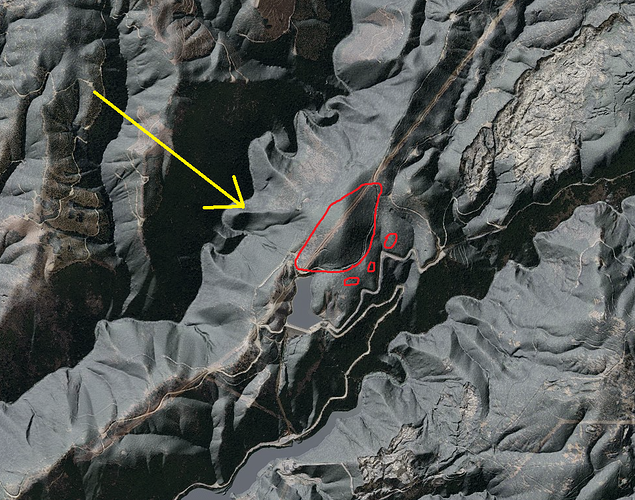And yes the obvious is wind. But I know I have been to a lot fires where wind didn’t play a factor until the fire started producing its own from intense heat and pulling air into the bottom of the column.
It ran out of slope. It torched as it got going but hit the ridge quickly. That spot it threw on the other side of the ridge didn’t do much.
It was said on here at the beginning that wind, slope, ignition were aligned, however, the start was basically on top of a peak, and the wind was not up drainage from what I mapped at the time, it was ENE headed cross drainage pushing the fire downhill somewhat, here is my crude sketch of how it ended up with the prevailing wind at the start drawn in.
Some of the locations of some of the spots look pretty spooky but it is in check now.
Forward Progress stopped
ENE aspect, on top of the ridge burning down slope, maybe higher fuels moistures and even thou it’s still hot we are loosing some solar heating because of sun angle. shadows are getting longer and heating shorter. Not to not much wind? Whatever the reason it didn’t get up and run, I’m good with it. Devine intervention, Maybe some good IA by Airforce and groundcrews.
I find it funny how so many people get hung up on ROS language… it is and will always be a very subjective observation. The ROS changes on a minute by minute basis. The point of a ROC is to build a snapshot in time of what the CO observes when they arrive.The minute a ROC is given on any incident it is invalid… the situation changes often rapidly. I know that many of you have been in that role… but think of all the factors which effect the words that come out of your mouth. This particular area is really hard to get to, much of what was reported was done so off of the smoke column( I suspect).
I happened to be looking for something else when I saw that column. I saw it before I even got the WD notification.
If you go back on the time lapse of the camera you see that the fire began on the downhill side of a power line right of way. The fire hit the grass in the cleared area and rapidly accelerated into the timber again. We have seen PL right away clearance areas adversely effect fire spread multiple times. In this instance it appears to have sped it up and allowed it to flank laterally into a wider fire front.
I am not sure that a fire needs to crown in the timber to meet a certain ROS. As for why it did not gain more energy… because several factors limited the energy curve.
The fire ran up a slope and reached the top quickly. There was wind… but it was light. There is a Type 2 copter a 5-7 minute flight from the fire. There was a water source within 1/2 mile of the fire. There was no competition for resources… 5 AT’s within the first 20 minutes with 3 of them being LAT’s. Three water dropper copters with 1 being a tanked type 1 within the first 25 mins.
The area looks to be managed timber… so perhaps some fuel modification was done.
Aggressive IA by competent hard working and dedicated FFers operating top of the line equipment with a mindset that we will hit an emerging fire hard and in the end save the CA tax payers money by keeping this fire from becoming a major incident.
I had an old school FC tell me once the way he measured it. I will quote.
“Slow means it’s moving so little you’re almost annoyed that you’re there.
Critical, rapid, dangerous whatever they are saying now means it puckers your as*>^le.
All other fires are moderate.”
Hard to argue with logic!!! That’s pretty easy to understand!
Well said sir…

